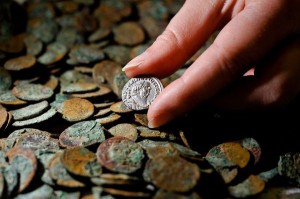Falling Down the Thames Blog 45, 21st January 2015
Treasures Beneath the Waves
I have been told by archaeologists that springs and wells have long held the fascination of humans. In a mystical sort of way, this makes some kind of sense; water is supposed to fall from the sky, and not boil up from the earth. Excavations at springs and wells often reveal large quantities of artifacts that appear to have been deliberately tossed into the water as votive offerings – items given by worshipers to fulfill a vow or to make a wish. In this era we might toss a coin into a well or fountain before making a wish.
Krista and I will begin our paddling adventure in April at the site generally regarded at the head of the River Thames. The site is in a dry field near the village of Kemble. Winter rains sometimes make waters rise up from a spring in this field, but when we begin our journey we will have a considerable hike to find the first stretch of water in which we can float our canoe. All of this leave me wondering what artifacts we might find if we used a metal detector at the spring, or if we started rooting around with a shovel and trowel. Roman coins? Saxon swords? Norman jewelry?
My imagination doesn’t end there. What treasures might be revealed if we were able to drain the non-tidal portion of the River Thames, even for an hour, while teams of archaeologists scoured the river bottom? Over the past two millennia of occupation, people must have dropped and thrown an endless array of precious items into the great waterway.
As the River Thames runs through London, this sort of investigation is sometimes possible. Where the river is tidal, the tug of the moon and the sun mean that the surface of the river is higher at some times of the day than at others. When the sun and moon are in alignment, high and low tides are particularly pronounced. In other words, there are times when evidence of London’s history is revealed to anyone willing to tromp out into the mudflats at low tide.
One woman has taken advantage of this opportunity to collected fragments of clay tobacco pipes, discarded in the River Thames centuries ago. After so long a residence in the mud of the Thames, many of these clay fragments have become smoothed and have taken up a beautiful stain. She turns these artifacts, some dating to the 16th century, into bracelets, earrings, necklaces, cufflinks and key chains, which are sold online.
Artifacts along our paddling route don’t have to be as tiny as the stem of a clay pipe, or as old as the Roman occupation of Britannia. On Sunday 3 May Krista and I will paddle past a really, really big object projecting up from the surface of the Thames. I will describe that history and current significance of that artifact in next week’s blog.
- Glen
Photo credits: Roman coin cache – news.nationalgeographic.com; clay pipe earrings by Amelia Parker – www.amelia-parker.com


